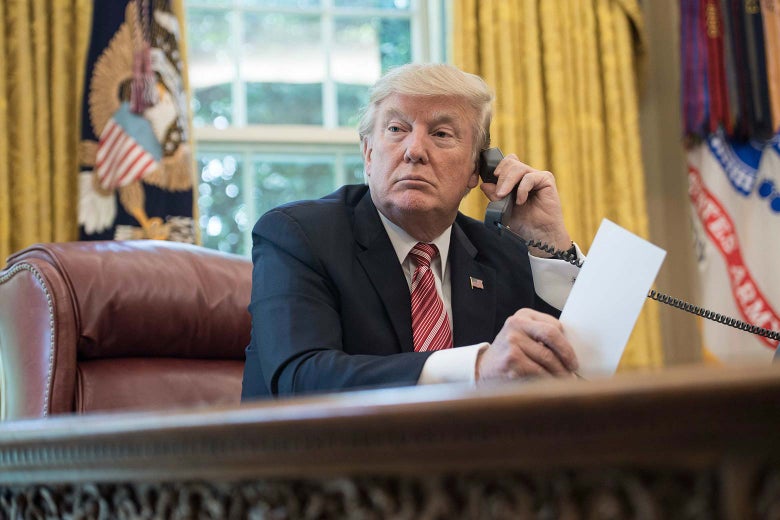
President Donald Trump on June 27, 2017, in Washington.
Nicholas Kamm/AFP/Getty Images
Reading the White House memorandum on President Donald Trump’s phone conversation with Ukrainian President Volodymyr Zelensky, a question comes to mind: Is this it, or is there more?
Of course, there’s quite a lot, as is. The memo shows Trump asking a foreign power for dirt on a possible opponent in next year’s presidential election, recruiting the attorney general to assist in this effort, and at least suggesting (if not quite proving) a quid pro quo between this help and the granting of military assistance.
But the memo is not a comprehensive document. Though many are calling it a “transcript,” that is not at all what it is. The document is titled “Memorandum of Telephone Conversation” (emphasis added). At the bottom of the New York Times’ reproduction of the memo, a fine-print note explicitly says as much:
Note: The five-page document distributed by the White House includes a cautionary note indicating that it was “not a verbatim transcript” but instead was based on “notes and recollections of Situation Room Duty officers” and national security staff. But senior officials said voice recognition software was used in preparing the “memorandum of telephone conversation,” which included long, direct quotations.
This process has long been standard procedure when presidents talk—on the phone or in person—with other leaders or with senior officials in their own administrations. I’ve read a lot of these declassified “MemCons” (memorandums of conversation) in presidential libraries. By historical standards, this one seems quite thorough and more detailed than most.
However, three things are worth noting. First, it is, as the footnote states, based on “notes and recollections” of staff officers who were listening in; as a result, they might be incomplete, possibly for innocent reasons. Second, whoever wrote this document might have deliberately omitted certain bits of dialogue.
Finally, take a close look at the last sentence of the Times’ footnote: “[V]oice recognition software was used” in preparing the document, allowing for “long, direct quotations.” This might explain the extraordinary detail. But it also suggests something else: There might be White House tapes. Are we witnessing this scandal’s Alexander Butterfield moment?
Butterfield was the White House staffer who revealed that President Richard Nixon was secretly recording conversations. The revelation came about entirely by chance: Butterfield was called to testify before the Senate Watergate Committee’s staff on July 13, 1973. Staff members asked him about memos of conversations that the White House had turned over. The quotations seemed far too detailed to be based on notes. One staffer recalled that John Dean, the White House counsel-turned-informer, had speculated that Nixon might have bugged the Oval Office, so he asked Butterfield if there was a tape-recording system. “I was wondering if someone would ask that,” Butterfield replied. It turned out that he had installed the system, and he proceeded to explain how it worked.
Once senators knew about the tapes, they moved to subpoena them. Nixon resisted. The challenge went all the way up to the Supreme Court, which ruled 8–0 that Nixon must turn over the tapes. He did, and the tapes revealed the “smoking gun”—tangible evidence that Nixon had ordered a cover-up for the Watergate break-in—that sealed his fate. Impeachment was clearly inevitable. Nixon resigned before the full House took a vote.
By historical standards, this one seems quite thorough and more detailed than most.
So, what kind of “voice-recognition software” is used to help the current White House aides monitor Trump’s phone conversations? How does this software enable the transcription of “long, direct quotations”? There might not be tapes, per se, but there is almost certainly a digitized record of the phone calls—and not just this call with Zelensky, but other calls with Vladimir Putin, Kim Jong-un, and other figures of interest.
Historians will be happy to hear this. Given the fact that many officials use private computers to send emails, I have long worried that vast archives of vital documents—the sorts of documents that have made many political history books possible—might not exist, at least not in a form that’s accessible to government archivists. But now we know that (unless they’re erased) computerized records of these vital phone calls do exist.
Maybe some of them will come to light even before the history books are written. Six House committees are now investigating various aspects of Trump’s presidency under the rubric of an impeachment inquiry. Now that digital records are said to exist, will the committees subpoena more of them? The records and resulting memorandums of conversation are classified. Each page of the Trump-Zelensky MemCon is stamped “SECRET/ORCON/NOFORN.” (ORCON is short for Originator Controlled dissemination, indicating that the document’s originator can track its possessors. NOFORN means the document cannot be distributed to foreigners.)
Trump declassified this memorandum, which is why we are all reading it. Presidents have the right to declassify whatever they want. But in releasing this specific memo, Trump may have created a precedent by which other materials relating to the same inquiry might also be declassified. Or at least he’s given the House Intelligence Committee, which is authorized to see material much more highly classified than this, a good argument for why other related material ought to be released.
In other words, the Zelensky memo may have revealed the existence of a vast and previously unknown trove of information that might be used to help seal the president’s fate.
Slate is covering the election issues that matter to you. Support our work with a Slate Plus membership. You’ll also get a suite of great benefits.
Join Slate Plusfrom Slate Magazine https://ift.tt/2lN27Mt
via IFTTT
沒有留言:
張貼留言